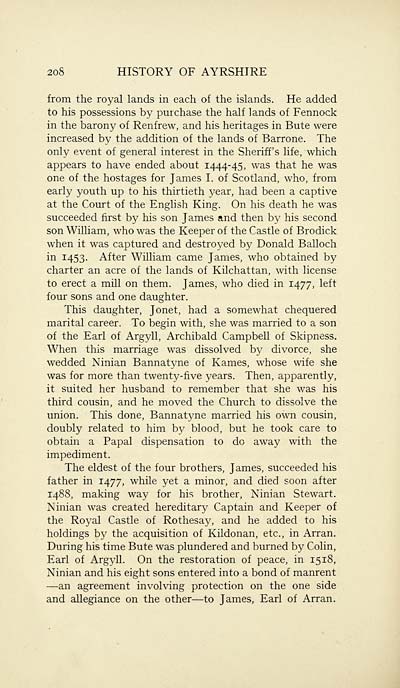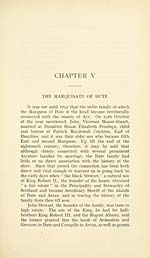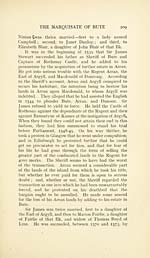Download files
Complete book:
Individual page:
Thumbnail gallery: Grid view | List view

208 HISTORY OF AYRSHIRE
from the royal lands in each of the islands. He added
to his possessions by purchase the half lands of Fennock
in the barony of Renfrew, and his heritages in Bute were
increased by the addition of the lands of Barrone. The
only event of general interest in the Sheriff's life, which
appears to have ended about 1444-45, was that he was
one of the hostages for James I. of Scotland, who, from
early youth up to his thirtieth year, had been a captive
at the Court of the English King. On his death he was
succeeded first by his son James and then by his second
son William, who was the Keeper of the Castle of Brodick
when it was captured and destroyed by Donald Balloch
in 1453. After William came James, who obtained by
charter an acre of the lands of Kilchattan, with license
to erect a mill on them. James, who died in 1477, left
four sons and one daughter.
This daughter, Jonet, had a somewhat chequered
marital career. To begin with, she was married to a son
of the Earl of Argyll, Archibald Campbell of Skipness.
When this marriage was dissolved by divorce, she
wedded Ninian Bannatyne of Kames, whose wife she
was for more than twenty-five years. Then, apparently,
it suited her husband to remember that she was his
third cousin, and he moved the Church to dissolve the
union. This done, Bannatyne married his own cousin,
doubly related to him by blood, but he took care to
obtain a Papal dispensation to do away with the
impediment.
The eldest of the four brothers, James, succeeded his
father in 1477, while yet a minor, and died soon after
1488, making way for his brother, Ninian Stewart.
Ninian was created hereditary Captain and Keeper of
the Royal Castle of Rothesay, and he added to his
holdings by the acquisition of Kildonan, etc., in Arran.
During his time Bute was plundered and burned by Colin,
Earl of Argyll. On the restoration of peace, in 15 18,
Ninian and his eight sons entered into a bond of manrent
— an agreement involving protection on the one side
and allegiance on the other — to James, Earl of Arran.
from the royal lands in each of the islands. He added
to his possessions by purchase the half lands of Fennock
in the barony of Renfrew, and his heritages in Bute were
increased by the addition of the lands of Barrone. The
only event of general interest in the Sheriff's life, which
appears to have ended about 1444-45, was that he was
one of the hostages for James I. of Scotland, who, from
early youth up to his thirtieth year, had been a captive
at the Court of the English King. On his death he was
succeeded first by his son James and then by his second
son William, who was the Keeper of the Castle of Brodick
when it was captured and destroyed by Donald Balloch
in 1453. After William came James, who obtained by
charter an acre of the lands of Kilchattan, with license
to erect a mill on them. James, who died in 1477, left
four sons and one daughter.
This daughter, Jonet, had a somewhat chequered
marital career. To begin with, she was married to a son
of the Earl of Argyll, Archibald Campbell of Skipness.
When this marriage was dissolved by divorce, she
wedded Ninian Bannatyne of Kames, whose wife she
was for more than twenty-five years. Then, apparently,
it suited her husband to remember that she was his
third cousin, and he moved the Church to dissolve the
union. This done, Bannatyne married his own cousin,
doubly related to him by blood, but he took care to
obtain a Papal dispensation to do away with the
impediment.
The eldest of the four brothers, James, succeeded his
father in 1477, while yet a minor, and died soon after
1488, making way for his brother, Ninian Stewart.
Ninian was created hereditary Captain and Keeper of
the Royal Castle of Rothesay, and he added to his
holdings by the acquisition of Kildonan, etc., in Arran.
During his time Bute was plundered and burned by Colin,
Earl of Argyll. On the restoration of peace, in 15 18,
Ninian and his eight sons entered into a bond of manrent
— an agreement involving protection on the one side
and allegiance on the other — to James, Earl of Arran.
Set display mode to:
![]() Universal Viewer |
Universal Viewer | ![]() Mirador |
Large image | Transcription
Mirador |
Large image | Transcription
Images and transcriptions on this page, including medium image downloads, may be used under the Creative Commons Attribution 4.0 International Licence unless otherwise stated. ![]()
| Histories of Scottish families > Ayrshire > Volume 2 > (218) Page 208 |
|---|
| Permanent URL | https://digital.nls.uk/95191714 |
|---|
| Attribution and copyright: |
|
|---|---|
| Description | A selection of almost 400 printed items relating to the history of Scottish families, mostly dating from the 19th and early 20th centuries. Includes memoirs, genealogies and clan histories, with a few produced by emigrant families. The earliest family history goes back to AD 916. |
|---|

